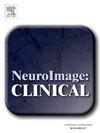Increased glymphatic system activity and thalamic vulnerability in drug-naive somatic depression: Evidenced by DTI-ALPS index
IF 3.6
2区 医学
Q2 NEUROIMAGING
引用次数: 0
Abstract
Major depressive disorder (MDD) is a significant contributor to global disease burden, with somatic symptoms frequently complicating its diagnosis and treatment. Recent advances in neuroimaging have provided insights into the neurobiological underpinnings of MDD, yet the role of the glymphatic system remains largely unexplored. This study aimed to assess glymphatic function in drug-naïve somatic depression (SMD) patients using the diffusion tensor image analysis along the perivascular space (DTI-ALPS) index. A total of 272 participants, including somatic depression patients (SMD), pure depression (PMD), and healthy controls (HC), were enrolled. We collected T1-weighted (T1w) and DTI (diffusion tensor image) scans and clinical data of all participants. The DTI-ALPS indices were calculated and compared among three groups. Gray matter regions associated with the DTI-ALPS index were identified by voxel-based morphometry analysis (VBM), revealing a cluster located in the thalamus. Then, we performed partial correlation analyses to further investigate the relationships between the DTI-ALPS index, thalamic volume, and clinical data. The DTI-ALPS index was significantly higher in the MDD group compared to the HC group, particularly in the SMD group. Furthermore, a significant positive correlation was observed between the DTI-ALPS index and thalamic volume, with lower DTI-ALPS values associated with reduced thalamic volumes, especially in the SMD group. Our findings suggest heightened glymphatic activity in MDD patients, especially SMD patients, and a potential link between glymphatic function and thalamic vulnerability. Therefore, the thalamus’ vulnerability to glymphatic system function may play a role in the pathophysiology of depression, particularly somatic depression, suggesting that both the glymphatic system and the thalamus could serve as potential therapeutic or intervention targets for future treatments.
经DTI-ALPS指数证实,未用药的躯体抑郁患者淋巴系统活性和丘脑易感性增加
重度抑郁障碍(MDD)是造成全球疾病负担的一个重要因素,其躯体症状经常使诊断和治疗复杂化。神经影像学的最新进展使人们对重度抑郁症的神经生物学基础有了更深入的了解,然而,人们在很大程度上仍未探究肾上腺系统的作用。本研究旨在利用沿血管周围空间的弥散张量图像分析(DTI-ALPS)指数评估药物治疗无效的躯体抑郁症(SMD)患者的肾上腺功能。我们共招募了 272 名参与者,包括躯体抑郁症患者(SMD)、单纯抑郁症患者(PMD)和健康对照组(HC)。我们收集了所有参与者的 T1 加权(T1w)和 DTI(弥散张量图像)扫描以及临床数据。我们计算了 DTI-ALPS 指数,并在三组之间进行了比较。通过体素形态计量分析(VBM)确定了与 DTI-ALPS 指数相关的灰质区域,发现了一个位于丘脑的集群。然后,我们进行了部分相关分析,进一步研究了DTI-ALPS指数、丘脑体积和临床数据之间的关系。MDD 组的 DTI-ALPS 指数明显高于 HC 组,尤其是在 SMD 组。此外,我们还观察到 DTI-ALPS 指数与丘脑体积之间存在明显的正相关性,DTI-ALPS 值越低,丘脑体积越小,尤其是在 SMD 组。我们的研究结果表明,MDD 患者(尤其是 SMD 患者)的肾上腺活动增强,肾上腺功能与丘脑的脆弱性之间存在潜在联系。因此,丘脑对 glymphatic 系统功能的脆弱性可能在抑郁症(尤其是躯体抑郁症)的病理生理学中发挥作用,这表明 glymphatic 系统和丘脑都可以作为未来治疗的潜在治疗或干预目标。
本文章由计算机程序翻译,如有差异,请以英文原文为准。
求助全文
约1分钟内获得全文
求助全文
来源期刊

Neuroimage-Clinical
NEUROIMAGING-
CiteScore
7.50
自引率
4.80%
发文量
368
审稿时长
52 days
期刊介绍:
NeuroImage: Clinical, a journal of diseases, disorders and syndromes involving the Nervous System, provides a vehicle for communicating important advances in the study of abnormal structure-function relationships of the human nervous system based on imaging.
The focus of NeuroImage: Clinical is on defining changes to the brain associated with primary neurologic and psychiatric diseases and disorders of the nervous system as well as behavioral syndromes and developmental conditions. The main criterion for judging papers is the extent of scientific advancement in the understanding of the pathophysiologic mechanisms of diseases and disorders, in identification of functional models that link clinical signs and symptoms with brain function and in the creation of image based tools applicable to a broad range of clinical needs including diagnosis, monitoring and tracking of illness, predicting therapeutic response and development of new treatments. Papers dealing with structure and function in animal models will also be considered if they reveal mechanisms that can be readily translated to human conditions.
 求助内容:
求助内容: 应助结果提醒方式:
应助结果提醒方式:


